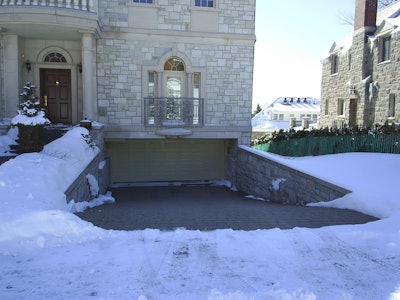 Designed for both commercial and residential settings, Emerson’s EasyHeat Sno Melter mats can be installed in concrete or (as seen here) under pavers to keep driveways, sidewalks and other areas clear of snow and ice.
Designed for both commercial and residential settings, Emerson’s EasyHeat Sno Melter mats can be installed in concrete or (as seen here) under pavers to keep driveways, sidewalks and other areas clear of snow and ice.Photo: Emerson
In the North, snow is an accepted aspect of winter, but it doesn’t mean that homeowners relish in the chores it implies.
Shoveling off a driveway is often a dreaded task and a particularly dangerous one if your clients are older. If you have a homeowner who is wanting to have their driveways or walkways cleared of snow without having to pay for someone to come shovel or plow, you can talk to them about installing a snow melt system.
Heated driveways are nothing new, but they are rising in popularity as more people view the convenience as well worth the money. To help a customer decide if a heated driveway is right for them, discuss these topics with them.
Budget
Let there be no confusion here, heated driveways are a luxury and can be far more expensive depending on the scale and materials chosen for this installation. There is not only the cost of installing the system but also the cost associated with removing the old driveway. Aside from having to remove an asphalt or concrete driveway, homeowners also have the option of having a beautiful paver drive installed over the system that can also drive up the cost.
Other factors that can affect the cost are whether the heated driveway can be connected to the house’s heating system or must stand on its own and whether the control scheme is manual or automated. While manual systems are cheaper, they do require the client to have the forethought to remember to activate the system before snow is on its way.
Automated controls run continuously at low levels and then begin operating at higher levels one the sensors detect snowfall. The more sophisticated the controls, the steeper the price tag.
Built-in system or portable mats
If your client isn’t prepared for an investment that could run anywhere from $10,000 to $15,000, there is the cheaper alternative of heated driveway mats. These mats focus on melting the bare minimum of pavement that is needed for a car’s tires, much like a ribbon driveway.
The product features slip-resistant rubber on the top and bottom with the heat element in between. The power cord is moisture resistant and can be plugged into a regular outlet. HeatTrak is one of the companies that manufacture this portable option.
The amount of time it takes to clear the snow compared to a built-in system depends on how much snow has fallen as well as the heat setting used. The mats also come in smaller sizes and can be used for walkways or steps, and they can also be taken with the customer if they move to a new house.
Electric or hydronic
If cost isn’t an issue and your customer prefers to have the whole driveway clear of snow, it comes down to determining how the driveway will be heated. The two popular systems are electric and hydronic and each comes with their own set of pros and cons.
Electric systems require less warm-up time and can respond faster. They are easier for retrofitting applications and have a decreased chance of breaking. These systems are simpler to design and are less expensive to purchase and install.
The drawback of the electric driveway heat systems is that larger systems can be harder to power and operating costs may be higher. Ben Bowen with Ross NW Watergardens advises that homeowners consult an electrician to determine if they have enough available power to melt snow for the entire driveway.
Meanwhile, hydronic heating systems use heated water mixed with glycol that is pumped through tubing under the driveway to melt snow. Homeowners have greater flexibility in power option sources with this system, which can result in lower operating costs.
Some of the disadvantages of hydronic heat systems are that it cannot be installed with an existing concrete driveway, the tubing can corrode over time and it is difficult to be installed, even for professionals.
Location
Once your client knows what sort of system they wants, it’s time to decide where all they will want the heated system. Some may just want the bare minimum of the driveway while others may decide they want the front walk and maybe even the back patio included.
It all depends on their budget, the amount of snow they encounter every year and their dislike for shoveling it that will determine the size of the project.









